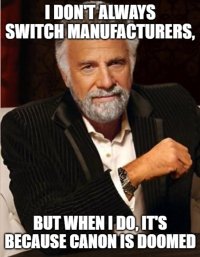Lots of talk about sales, who is the leader in market share, etc. Since this is not sports, where one roots for a particular team, often for no rational reason, I could not care less who sells the most. I am often amazed at the number of people who seem to care so much about this. Maybe because over the years I have owned Canon, Olympus, Nikon and Sony cameras, I have no particular allegiance. But even if I only owned Canon, I doubt I would care if they were number 1, 2, or 3 in the market share race. What I think is more important is who makes the best equipment. Who makes it easier to get the shot you want. This is the reason I often praise or defend the companies I think do the best job and criticize those that don't. Obviously, I do not have any actual data in regards to repair figures or what materials and workmanship go into the products from the various brands. I only have my own experience and whatever anecdotal information one sees on forums over the years as well as internet articles, reviews, and Facebook groups. Based on that quite possibly inaccurate information, I form my opinions. Which is why I often praise Canon, Olympus (now OM Systems) and Nikon and trash Sony. And am amazed at the popularity that Sony has, and credit that success to their less than admirable marketing success. I would never recommend Sony to any new photographer, but would have no problem recommending Canon, OM Systems or Nikon. While spec-wise the brands are all similar, my opinion is that Sony makes the cheapest (not talking price here) cameras, taking numerous shortcuts when it comes to overall quality, and one's shooting experience. I believe their shutters have been the cheapest and most fragile. I have seen numerous posts on Facebook groups of people with torn shutters and comments that indicate that this is pretty normal after about 100,000 shots. There was also a class action lawsuit a couple years ago in regards the shutters tearing with less then 5,000 shots, if I remember correctly. Reviewers comparing the EVF of The Nikon Z9, compared it to the latest comparable Sony and wished the Nikon had the same higher resolution, but all of the reviewers preferred the NIkon EVF! Clearer, better image, leading them to conclude that Sony was using cheaper glass in their EVF. Sony's issue with dust on sensors was well known, thus leading me to believe that the dust removal system was either much cheaper (or perhaps non existent). Ergonomically, Sony has clearly cut corners and only in their most recent models has made major improvements, but even now, the distance between grip and lens is insufficient for many. I will admit that that the last Sony I owned was their 2nd generation A7. So, things are obviously better now, but I have to wonder if the philosophy has actually changed much, That camera was nowhere near the quality of my Canon 6D that I thought I was going to replace, or my Olympus E-M1 mark II. It was, by far, the worst camera I have ever owned. I see no reason to think things have changed at Sony. They seem to prioritize specs and cut corners when it comes to everyhting else. Just my opinion, of course, but that is far more important to me than sales figures or who is market leader.

